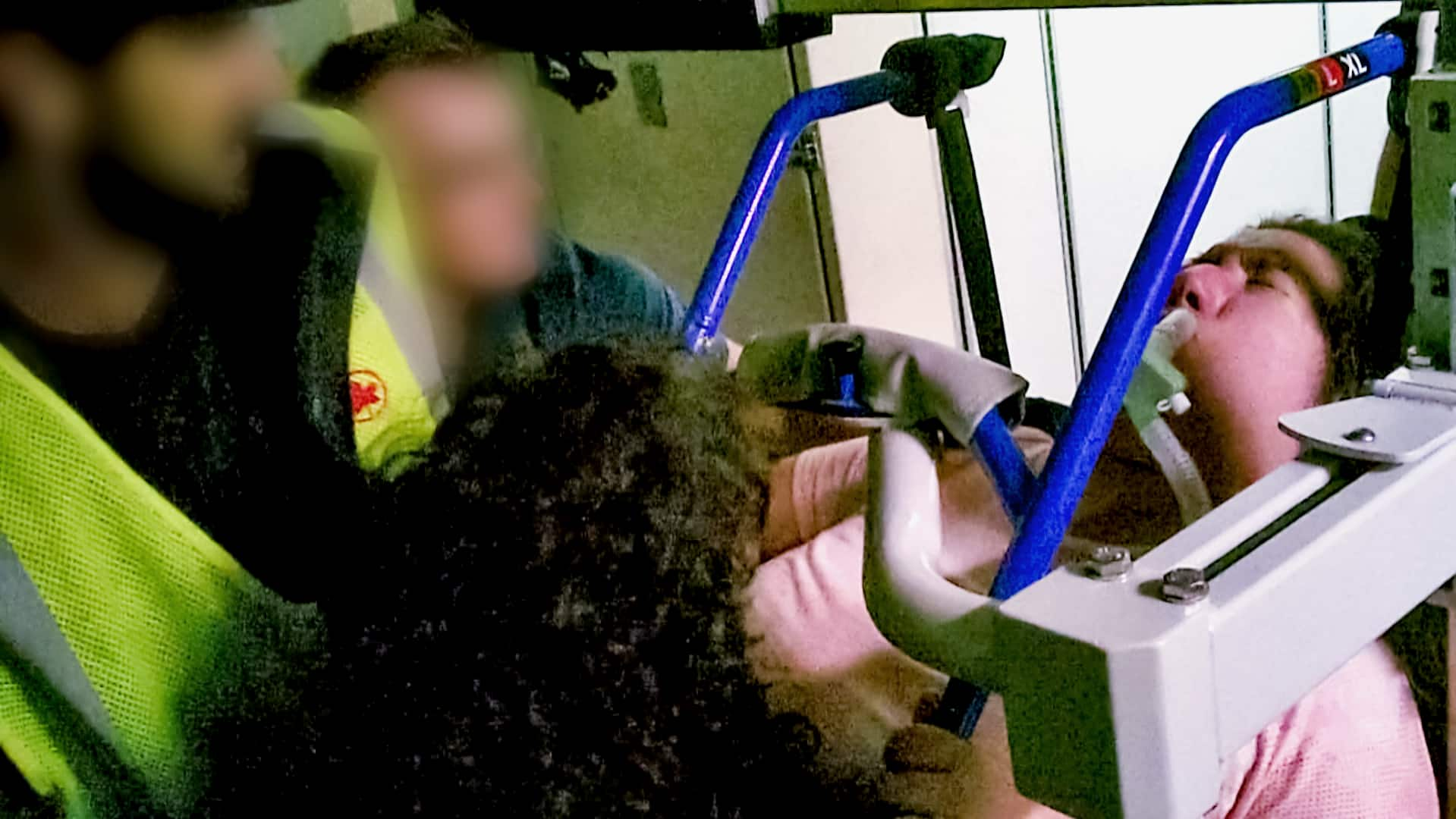Months-long Marketplace investigation reveals people with disabilities facing safety issues while travelling.

A Toronto woman who uses a power wheelchair had her ventilator disconnected and a lift fall on her head, all on a single journey, as Air Canada staff struggled to transfer her between the aircraft and her wheelchair, a new Marketplace hidden-camera investigation shows.
“I did not feel safe,” Alessia Di Virgilio said after the incident.
In light of the federal government summoning Air Canada to Ottawa this week to discuss a spate of reports about the mistreatment of customers in wheelchairs, Marketplace is releasing an exclusive preview of its hidden-camera investigation which documented a rarely seen first-hand account of the challenges faced by those flying with a disability.
Marketplace accompanied Di Virgilio on a round trip with Air Canada from Toronto to Charlottetown where hidden cameras captured a multitude of issues. Di Virgilio agreed to let Marketplace document her journey to raise awareness of the ordeal people who use wheelchairs go through when getting on flights.
Marketplace showed the hidden-camera footage to Jeff Preston, an associate professor of disability studies at King’s University College in London, Ont. As a power wheelchair user himself, he said these issues are far too common.

“This moment of remembering that you don’t have the same rights or the same access as other Canadians, that you are asked to fundamentally live a lesser life because of your difference, that it’s your responsibility to fit within this broken system as opposed to the system saying we need to do fundamentally better,” he said.
Di Virgilio was born with a mobility disability that impacts her muscles and her lungs. She can’t sit up without support and uses a ventilator to help her breathe. Her wheelchair is custom-built to support these needs and give her independence.
“I think that as people with disabilities, often things that are recreational are [deemed] frivolous,” she said. “But it goes to quality of life and that’s the difference between life and living.”
In addition to documenting Di Virgilio’s experience with airline travel, Marketplace’s investigation will highlight accessibility issues across Canada’s transit systems, including using vehicles-for-hire with service animals and navigating public transit with a disability.
- You can watch the full investigation, “Access Denied”, Friday, Nov. 10, at 8 p.m., 8:30 in Newfoundland, on CBC TV and anytime on YouTube or CBC Gem.
‘People didn’t really know what they were doing’
Di Virgilio says the main problem is the requirement to be separated from her wheelchair during flights. The Canadian Transportation Agency requires passengers who use wheelchairs to sit in airplane seats, and most mobility devices must be stowed in the cargo hold along with travellers’ luggage. Passengers must also call ahead to ensure their mobility aids can fit through the cargo door, which varies in size depending on the aircraft. Di Virgilio’s chair was only a few centimetres under the height limit.
The regulations also require airlines to ensure properly trained staff conduct the transfers of people who use wheelchairs, but Di Virgilio doesn’t always trust that training. “It just felt like people weren’t trained properly,” she said of the final transfer at Pearson International Airport. “People didn’t really know what they were doing.”
CBC News hasreceived many stories of discomfort or injury during transfers or damages to wheelchairs when they’re placed in cargo.
Preston says transferring someone from their wheelchair to an airplane chair can be outright dangerous if that person falls. “I have a spinal cord surgery that was done when I was very young, with two rods on my spine. If I have a really extreme impact on those rods and they break, it will result in paralysis, if not death.”
‘Physical and emotional toll’
Issues during the flight were not the only problems Marketplace documented. Di Virgilio began experiencing complications with Air Canada before her trip began. Prior to travel, Di Virgilio first had to submit personal medical information to Air Canada. The airline’s “Fitness for Air Travel” form must be filled out by a traveller’s health-care provider and asks for detailed information including heart rate, blood pressure and whether the traveller can control their own bowels.

Di Virgilio submitted the form a week before her flight, but 24 hours before her scheduled departure, Air Canada told Di Virgilio she also needed clearance from a respirologist. An appointment with her specialist typically must be booked months in advance.
In a scramble, Di Virgilio was able to receive clearance from her specialist and Air Canada, but the next day, at Toronto’s Pearson Airport, Air Canada’s desk staff didn’t have that information. It took 40 minutes for staff to confirm her medical clearance and check her in.
“People don’t realize the type of physical and emotional toll that it puts on us even though we pay the same airfare as someone who doesn’t need to go through that,” said Di Virgilio.
By this point, Di Virgilio had been reducing her liquid intake for four days, and had taken medication to stop bowel movements. Once she left her house, she said, there was no way for her to use the washroom until arriving at her hotel, where a lift would be available over nine hours later.
‘Big problem’ with boarding
Once she made it to the gate, Di Virgilio watched as Air Canada staff allowed first class passengers to board before her.
“This is going to be a big problem,” said Erika Katzman, Di Virgilio’s support person and friend.
“Watching me in my most vulnerable state … it’s undignified to have to show myself in front of all these people,” Di Virgilio said to an airline employee.
Di Virgilio asked for boarding to be halted, and Air Canada staff appeared to scramble to find a working lift and staff to assist transferring her from her wheelchair to her plane seat, resulting in the flight being delayed.
On board, without the support of her wheelchair, Di Virgilio said she just tries to find “a moment of comfort.”
“I just feel like the system, the planes, the structure, the process, the bureaucracy … is not meant for people like me. And when you try and enjoy a little bit of life, this is what you get to get there.… It’s just hard,” said Di Virgilio.
‘I did not feel safe’ on return trip
Di Virgilio’s flight home came with its own issues. At Charlottetown Airport, no lift was available, so five staff members, led by Katzman, transferred Di Virgilio into a narrow wheelchair called an aisle chair.
The transfer happened on an uncovered ramp in the rain just outside the cabin door. Hidden-camera footage captured the moment Di Virgilio’s ventilator briefly detached after she was placed in the aisle chair. The tube disconnected several times during the transfers for this trip. Di Virgilio said without it she only has a few breaths before her breathing becomes shallow.
The scariest moment for Di Virgilio, she said, was the final transfer she endured when the plane landed back in Toronto. “I felt terrified.… I was really afraid,” said Di Virgilio.
Hidden cameras captured remarks by Air Canada staff suggesting they were not confident in using the equipment or properly trained.

Hidden camera catches ‘traumatic’ moment lift falls on passenger’s head when Air Canada staff struggle during the transfer to her wheelchair
Marketplace is releasing an exclusive preview of its hidden camera investigation which documented a rarely seen first-hand account of the challenges faced by those flying with a disability.
“Sorry, I haven’t used this machine in probably seven years,” a staff member told her.
“I was not confident, and I did not feel safe,” reflected Di Virgilio.
Staff seemed to operate the lift by trial and error as Di Virgilio pleaded with them. She grimaced in pain as her body was manoeuvred into the lift.
“Please guys, please,” she begged.
Then the lift tilted over. “It hit me in the head,” Di Virgilio said.
“To say the word terrifying just doesn’t fully [capture]how you feel,” reflected Di Virgilio, a few days after returning home. “It was just such an overwhelming experience.… I just kind of shut down from there.”

Air Canada wouldn’t comment on Di Virgilio’s specific case. In a statement the airline said, “The vast, vast majority of customers with mobility needs travelled without issue and in those relatively rare instances where barriers were encountered, we moved quickly to address concerns.”
Air Canada also said they had since reached out to Di Virgilio to apologize.
The Canadian Transportation Agency (CTA) told Marketplace it prioritizes accessibility-related complaints, and that “even in the absence of a complaint, when we are made aware of an egregious incident that could be a violation of the regulations, we ask our enforcement team to look into the incident.” The regulator added they couldn’t comment on Di Virgilio’s case because it might come before it as a complaint.
Preston says Air Canada and the CTA need to take responsibility for how they handle accessibility. “Ultimately when somebody’s rights are being violated, when someone is fundamentally treated as a lesser-than person, I think we all have responsibility to intervene.… We need to do a much better job at ensuring that what is on paper is actually being enacted in the real world. Because that gap, in my experience, can be massive.”
Di Virgilio wants action from Air Canada. “I have shared my medical documentation, I’ve given you my body, my experience, my money, my insight, my feedback, and so I would say, now what are you going to do with it?”
ABOUT THE AUTHOR
Jenny Cowley is an investigative journalist in Toronto. She has previously reported for CBC in Nova Scotia. You can reach her at Jenny.cowley@cbc.ca.
*****
Credit belongs to : www.cbc.ca
 Atin Ito First Filipino Community Newspaper in Ontario
Atin Ito First Filipino Community Newspaper in Ontario






